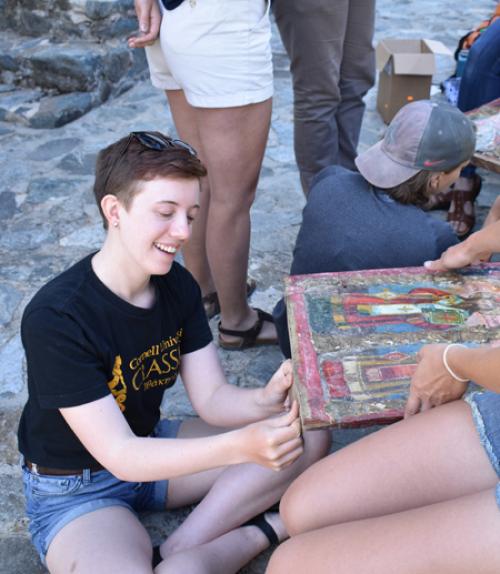Undergraduate and graduate students from Cornell worked with collaborators in Cyprus to apply tree-ring dating to clarify the ages of parts of the church of the Holy Cross at Palendri, a 12th century AD cultural heritage monument in Cyprus. The students participated in a seminar on dendrochronology and architectural history held on June 14th at the Church of the Holy Cross in the village of Pelendri, led by Sturt Manning, Goldwin Smith Professor of Classical Archaeology, and Cyprus Institute Professor Nikolas Bakirtzis. The seminar introduced students to methods of dendrochronology and architectural history.
“The church has extraordinary wall paintings and a complex architectural history from the 12th-16th centuries AD,” Manning said. “Students got to see and be with this history, were also taught how to apply dendrochronology and then actually assisted in the dendrochronological sampling of several elements of this church.”
Dendrochronology or tree-ring dating has been a recognized scientific technique since the early 1900s. Many species of trees in temperate zones, and some in tropical zones, grow one visible ring per calendar year. For the entire period of a tree’s life, a year-by-year record or ring pattern is formed that in some way reflects the climatic and environmental condition in which the tree grew. Thus, dendrochronology measures, compares and matches tree-ring growth, offering invaluable information on the age of the wood used by builders and artists and can help to date buildings, wooden objects and works of art such as icons.
“Students discovered that mundane things like the bottoms of worn-looking doors and the ends of wood beams high up in walls turned out to preserve key historical information,” Manning said. “The saying about 99 percent perspiration and 1 percent inspiration was also discovered literally to be true, again, as hard work and care were needed to get every sample including forensic cleaning and sanding to get useful scans of the worn bottoms of some historic doors.”
The seminar was organized as part of an ongoing collaboration between The Science and Technology in Archaeology Research Center (STARC) of The Cyprus Institute and the Cornell Tree Ring Laboratory and the Department of Antiquities of Cyprus. The event marks an expanding collaboration between Cornell and the Cyprus Institute.
“The international setting and collaboration made this a rich intellectual experience,” Manning said. “Students also learned the importance of looking at problems from every angle and in unexpected places.”





